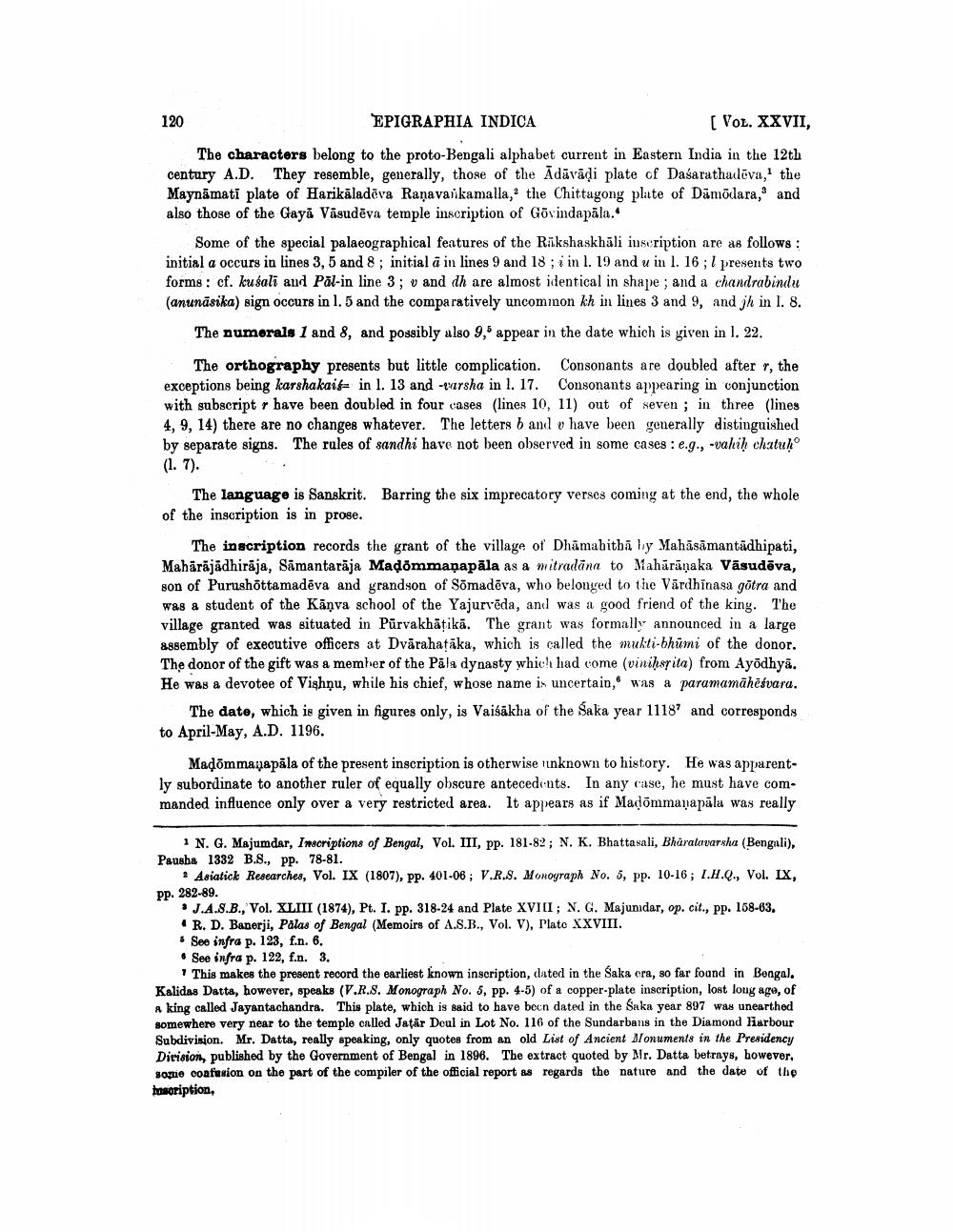________________
120 EPIGRAPHIA INDICA
(VOL. XXVII, The characters belong to the proto-Bengali alphabet current in Eastern India in the 12th century A.D. They resemble, generally, those of the Ādāvāļi plate of Dasarathadēva, the Maynāmati plate of Harikāladēva Raņavaikamalla, the Chittagong plate of Dāmādara, and also those of the Gaya Vāsudēva temple inscription of Govindapāla..
Some of the special palaeographical features of the Rakshaskhāli inscription are as follows: initial a occurs in lines 3, 5 and 8; initial a in lines 9 and 18 ; i in l. 19 and u in l. 16; 1 presents two forms: cf. kusali and Pal-in line 3; v and dh are almost identical in shape; and a chandrabindu (anunāsika) sign occurs in 1.5 and the comparatively uncommon kh in lines 3 and 9, and jh in l. 8.
The numerals 1 and 8, and possibly also 9,5 appear in the date which is given in l. 22.
The orthography presents but little complication. Consonants are doubled after r, the exceptions being karshakaif- in l. 13 and -varsha in 1. 17. Consonants appearing in conjunction with subscript r have been doubled in four cases (lines 10, 11) out of seven ; in three lines 4, 9, 14) there are no changes whatever. The letters b and have been gonerally distinguished by separate signs. The rules of sandhi have not been observed in some cases : e.g., -vahiḥ chatuh (1. 7).
The language is Sanskrit. Barring the six imprecatory verses coming at the end, the whole of the inscription is in prose.
The inscription records the grant of the village of Dhāmabithā ly Mahāsāmantādhipati, Mahārājādhiraja, Samantarāja Madommaņapāla as a mitradāna to Mahārāṇaka Vasudēva, son of Purushottamadēva and grandson of Somadēva, who belonged to the Vārdhinasa götra and was a student of the Kāņva school of the Yajurvēda, and was a good friend of the king. The village granted was situated in Pūrvakhātikā. The grant was formally announced in a large 888embly of executive officers at Dvärahatāka, which is called the mukti-bhūmi of the donor. The donor of the gift was a member of the Pala dynasty which had come (viniharita) from Ayodhyā. He was a devotee of Vishnu, while his chief, whose name is uncertain, was a paramamāhēsvara.
The date, which is given in figures only, is Vaišākha of the Saka year 1118? and corresponds to April-May, A.D. 1196.
Maçõmmapapāla of the present inscription is otherwise inknown to history. He was apparently subordinate to another ruler of equally obscure antecedents. In any case, he must have commanded influence only over a very restricted area. It appears as if Madõmmaņapāla was really
1 N. G. Majumdar, Inscriptions of Bengal, Vol. III, pp. 181-82; N. K. Bhattasali, Bharatavarsha (Bengali), Pausha 1332 B.8., pp. 78-81.
Asiatick Researches, Vol. IX (1807), pp. 401-08; V.R.S. Monograph No. 5, pp. 10-16; I.H.Q., Vol. IX, pp. 282-89.
* J.A.S.B., Vol. XLIII (1874), Pt. I. pp. 318-24 and Plate XVIII; N. G. Majundar, op. cit., pp. 158-63.
R. D. Banerji, Pålas of Bengal (Memoirs of A.S.B., Vol. V), Plate XXVIII. See infra p. 123, f.n. 6. • See infra p. 122, f.n. 3.
* This makes the present record the earliest known inscription, dated in the Saka cra, so far found in Bengal, Kalidas Datta, however, speaks (V.R.S. Monograph No. 5, pp. 4-5) of a copper-plate inscription, lost loug age, of A king called Jayantachandra. This plate, which is said to have been dated in the Saka year 897 was unearthed somewhere very near to the temple onlled Jatar Doul in Lot No. 116 of the Sundarbans in the Diamond liarbour Subdivision. Mr. Datta, really speaking, only quotes from an old List of Ancient Alonuments in the Presidency Division, published by the Government of Bengal in 1896. The extract quoted by Mr. Datta betrays, however, sogue confusion on the part of the compiler of the official report as regards the nature and the date of the basoription.




